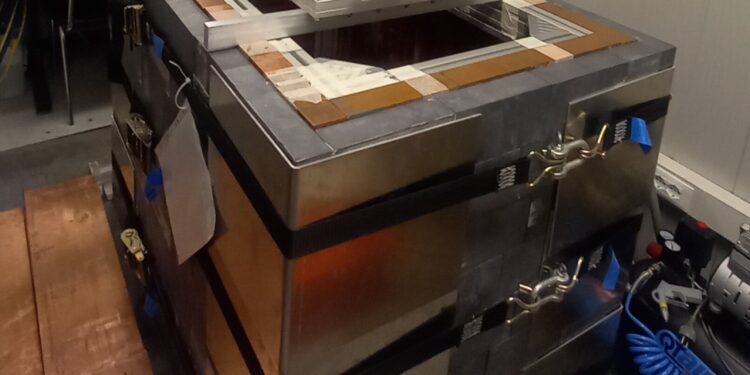The “VIP” experimental device used to study the foundations of quantum mechanics and rival theories at the LNGS-INFN underground laboratory in Gran Sasso. Credit: Catalina Curceanu (2024).
The apparent strangeness of the quantum world is often illustrated by the paradox of Schrödinger’s imaginary cat, which exists in a state of limbo, both alive and dead until an observer looks at it. But in the real world, we never encounter such zombie felines.
Quantum effects don’t seem to extend to very large objects—like cats, people, or houses—and physicists disagree about exactly why. Now, an international team of scientists has proposed a new, more precise way to test the validity of some alternative models to standard quantum theory that offer a possible explanation.
Their work was published in the journal Physical Exam Letters in June 2024.
According to standard quantum theory, before an object is observed, it can exist in a superposition state with multiple conflicting properties. A simplified way to understand this is to say that particles can be in two places at once, or that a radioactive atom can have decayed and not decayed at the same time, explains Catalina Curceanu, a FQxI member and experimental nuclear and quantum physicist at the National Institute of Nuclear Physics (INFN) in Frascati, Italy.
“So if you imagine putting a cat in a box with a vial of poison that will be released when a radioactive atom decays, there is a scenario in which the radioactive source is in a superposition of decayed and non-decayed states, and so the vial is both open and closed, the poison is both released and contained, and the cat is in a superposition of life and death,” she says.
Experiments have already observed such superpositions on objects as large as a sapphire crystal weighing 16 micrograms. According to standard quantum theory, such superpositions could in principle persist in even larger objects. But we do not observe them in everyday life.
Physicists describe quantum systems mathematically using a “wave function” that tracks their evolution. “For some unknown reason, these wave functions, when observed, tend to collapse. At that point, quantum systems behave like everyday “classical” systems, losing their true quantum attributes,” Curceanu explains.
“But standard quantum theory cannot tell us how or why this happens. This is the very essence of the so-called ‘measurement problem’ in quantum mechanics.”
The measurement problem has led independent teams of scientists to develop a series of different explanations, including “quantum collapse models” – rival alternatives to standard quantum theory “that propose that a physical process triggers the collapse of the wave function in such a way that the larger the system, the faster the collapse,” Curceanu says.
These models are exciting because they predict effects that don’t exist in standard quantum mechanics, in the form of spontaneous radiation, Curceanu says. “This means that experiments could one day prove that these models are correct,” she says.
Evidence of collapse
There are two main types of quantum collapse models: the first are called continuous spontaneous localization (CSL) models, in which the collapse is caused by an intrinsic, random process, which may or may not be related to gravity or anything else. This process occurs spontaneously and continuously.
In the second set of models, the collapse is explicitly linked to gravity, for example in the so-called Diósi-Penrose models, developed independently by FQxI members Lajos Diósi of Eötvös Loránd University, Budapest, Hungary, and Nobel Prize-winning physicist Roger Penrose of the University of Oxford, UK.
Curceanu and his colleagues, along with other independent groups, have spent many years looking for signs of such spontaneous radiation, in the form of high-energy “gamma” radiation. But so far, they have found no evidence of its existence. This has allowed physicists to constrain and rule out various versions of collapse models, especially the simplest version of the gravity-related collapse models, and also to constrain the parameters of the CSL models.
In their most recent work in Physical Exam LettersCurceanu, Diósi, Kristian Piscicchia and Simone Manti, also from INFN, Sandro Donadi from Queen’s University, Belfast, Ireland, Angelo Bassi from the University of Trieste, Italy, and FQxI member Maaneli Derakhshani from Rutgers University in New Jersey, calculated the characteristics of the spontaneous electromagnetic radiation that should be emitted by atomic systems at lower energies, in the X-ray range.
The team found large differences with previous predictions for the simplest models. “Quite surprisingly, in this low-energy regime, the spontaneous radiation rate turned out to be strongly dependent on the atomic species studied,” Piscicchia says.
“For the first time, we also found that the emission depends on the specific collapse model,” Manti says.
Curceanu and his colleagues are updating their own experiment, performed at the LNGS-INFN underground laboratory in Italy, to search for these X-rays. They plan to explore the predicted relationship between spontaneous radiation and atomic structure in dedicated experiments using multiple targets.
“This would allow us to better constrain collapse models and, if a signal is found, determine its cause, which, of course, would have enormous implications across all of science,” Curceanu says.
More information:
Kristian Piscicchia et al., X-ray emission from atomic systems can distinguish between dominant dynamical wave function collapse models, Physical Exam Letters (2024). DOI: 10.1103/PhysRevLett.132.250203
Provided by the Foundational Questions Institute, FQXi
Quote:X-rays from atomic systems could reveal new clues to rival quantum theories (2024, September 9) retrieved September 10, 2024 from
This document is subject to copyright. Apart from any fair dealing for the purpose of private study or research, no part may be reproduced without written permission. The content is provided for informational purposes only.



